To facilitate the process of locating coordinates on a map or globe, scientists have established reference lines, known as meridians and parallels, on the Earth’s surface. Among these lines, the Greenwich meridian and the equator hold a significant position.
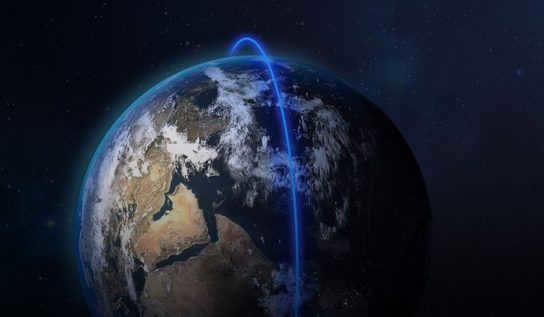
Parallels, meridians, and other lines
When attempting to virtually divide the globe into separate parts, a circular shape can be obtained on the cut, and there may be traces on the surface corresponding to circles of various sizes and diameters. The largest circle in this imaginary division of the planet will be characterized by passing through the planet’s core, and the longest circle that limits it.

It is important to note that when dividing the Earth’s surface into equal parallel slices, all the circles will be perfectly aligned parallel to one another.
Geography refers to these circles, which are created by an imaginary division of the Earth’s surface, as parallels. They are typically depicted on maps or globes. The points where the circles converge into single points are located at the poles of the planet.
These points are situated at the intersections of the Earth’s hypothetical axis of rotation with its surface, and the lines connecting the poles are of equal length and are known as meridians.
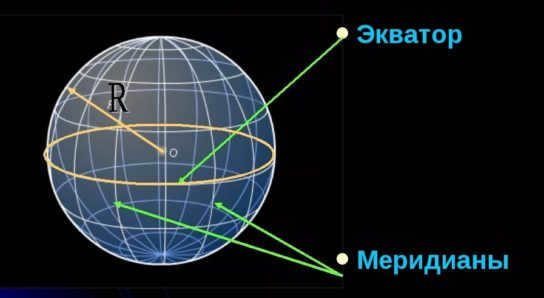
Definition
The equator is a term used in geography to describe an imaginary line that runs across the surface of a planet, stretching from east to west. This line is perpendicular to the intersection of the Earth’s axis between the two poles, which are the northernmost and southernmost points.
The equator divides the planet into two equal hemispheres: the Northern Hemisphere and the Southern Hemisphere. It serves as a crucial reference point for navigation purposes, as its latitude is set at zero. This means that other lines of latitude, both north and south of the equator, are measured in relation to it.
Thus, any other lines of section by planes, concerning the equator, are commonly referred to as parallels, all of which essentially intersect the equator at equal distances.
The equator is defined as having a latitude of zero, which is a crucial value in the fields of geography, navigation, and exploration. It serves as the starting point for studying the various characteristics and intricacies of the planet that are related to latitude.
The equator is a concept in the geographic coordinate system that represents latitude. Similarly, the Greenwich or prime meridian is a concept that represents longitude, with its reference point being the observatory located in the northern district of London.
In geography, there are multiple definitions of what constitutes the equator. Some common ones include:
- The longest line in its length;
- The line that divides the meridian into equal parts when it crosses;
- The line at zero latitude;
- The line that has the same length as the poles.
Characteristics of the equator
The equator is an imaginary circular line that runs through the center of the Earth, encircling the entire planet. It is the most important circle on Earth (by the way, no one has yet been able to complete a trip around the world along the equator).
There is a monument with a zero mark on the Earth, located near the capital of Ecuador. From this monument, there is a line that symbolically represents the equator. However, the equator itself is actually located about 250 meters to the north, passing through the Museum of the Sun.
The equator, which is perpendicular to the rotation axis of the planet, is unique in that it maintains the same distance from the pole points.
What sets the equator apart is that it spans across all the oceans (excluding the northern ones) and experiences equal day and night duration throughout the year.
It is worth noting that the equator is home to the only active volcano, Volcano Wolf, located in Ecuador’s Galapagos Islands. The volcano recently erupted, with the last eruption occurring seven years ago.
The role of the equator
The equator plays a unique role as the only perfect great circle on the planet. This is because any circle drawn on a sphere or spheroid, with its base passing through the center of the sphere, can be considered a great circle. In contrast, all other lines of latitude, both north and south, do not form perfect circles. As they move closer to the poles, these lines gradually narrow and deviate from the base of the planet. While these lines can also be considered circles, their flattened shape, similar to the overall shape of the planet, means that their circumference does not match that of the equator.
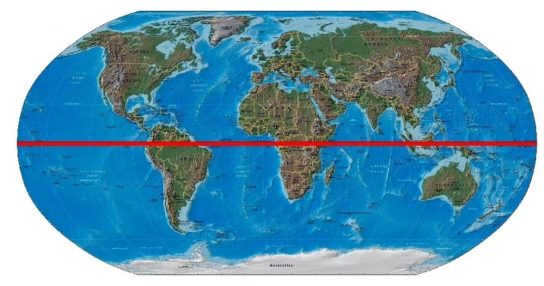
It is fascinating to note that at the equator (as well as in its vicinity), the sun is directly overhead (at a maximum angle of 25 degrees from the zenith) and remains so throughout the year on a daily basis.
If we consider the equinoxes (the autumn equinox in September and the spring equinox in March), we can observe that on these specific days the sunspot, which is the point of sunrise, crosses the equator at a small angle. This means that sunlight will be present at all latitudes of the equator for 24 hours, both day and night, as the sunlight falls perpendicular to the planet’s axis of rotation at this moment. Shadows are not cast during this time, and if we take into account Baer’s famous law regarding the rotation of the water vortex, we can see that its direction is opposite to the north and south of the equator line.
Measurement of the equator
The length of the equator is considered one of the fundamental and crucial metric characteristics of the Earth in the field of geography. This parameter is widely utilized in geographical and geodetic calculations, as well as in astrology.
Due to the Earth’s shape, which is not a perfect sphere but rather an ellipsoid with a slight flattening at the poles and significant curvature at the equator (caused by gravity and rotation), the equatorial circumference exceeds the polar diameter by 42.7 kilometers, measuring 12,713.5 kilometers.
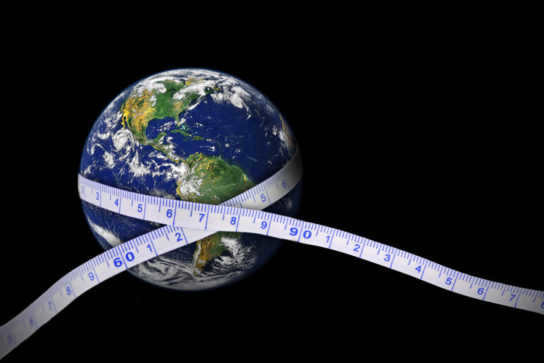
In addition, just as the planet’s diameter is elongated at the equator due to the equatorial bulge, the circumference is also slightly stretched in this region. Consequently, the circumference at the poles measures 4,008 kilometers, while at the equator it is 4,075 kilometers.
Due to its flattened ellipsoidal shape, the planet’s linear rotation rate is higher at the equator compared to other regions. This is because the Earth’s circumference at the equator allows it to complete a full revolution around its axis in 24 hours. To calculate the linear speed of rotation, simply divide the circumference by 24 hours, resulting in an approximate speed of 2,000 kilometers per hour. However, when moving in the north or south direction, the circumference decreases, leading to a lower linear speed of rotation.
It is important to note that the Earth’s circumference is not consistent throughout, resulting in varying radii at different points. For example, the radius at the equator is approximately 6,378 kilometers, while at the poles it is approximately 6,356 kilometers.
Usually, the length of the equator is calculated using a radius of 6371 km, owing to this reason.
Equatorial Climate
The equator stands out from other parts of the world due to its unique physical environment and geographical position, which affects its climate significantly.
The climate at the equator remains relatively consistent throughout the year, with warm conditions (either wet or dry) being the prevailing factor. The equator experiences high levels of humidity, primarily because it receives an extensive amount of sunlight compared to other regions.

As one moves away from the equator, whether northward or southward, the level of solar energy and light gradually decreases. This gradual decrease creates suitable conditions for the development of various climate forms. The equatorial region is known for its diverse tropical climate, which supports a wide range of flora and fauna.
However, the climate on the equator can also exhibit diversity. For instance, the highest point on the equator is found at an altitude of 4690 meters on the Cayambe volcano in Ecuador, where the only glacier on this line is located.
What countries are situated on the equator?
The equator, besides traversing dense tropical regions, passes through the territories of 14 countries, both on land and water. Apart from Ecuador, this line cuts across the lands of several other countries, including Congo, Sao Tome, Gabon, Uganda, Somalia, Maldives, Kenya, Indonesia, Colombia, and Brazil, among others. Many of these countries are small and have low population densities, but some, like Brazil and Ecuador, have large populations and boast major cities along the equator. For instance, Ecuador’s capital is located very close to the equator, just one kilometer away, and it is there that you can find a museum and a monument dedicated to the equator.

There are multiple cities located on the equator line in various countries. For example, in Brazil, there is Macapa, while in Ecuador, there is Quito. Additionally, the equator line can be found in Kenya, Indonesia, Congo, and Uganda, specifically in the capital city of Kampala.
In addition to these cities, the equator line also intersects with a significant number of islands. For instance, in Indonesia, there are 17 islands, including some located in a lake in Kalimantan. Furthermore, there are nine islands near the mouth of the Amazon River and five islands within Lake Victoria in Africa.

Oceans along the equator
The equator intersects several continents, including Africa and South America, and among the oceans that lie within its bounds, three main ones can be distinguished – the Atlantic, the Pacific, and the Indian Ocean.
The equator line traverses the Atlantic Ocean along the prime meridian, touching the territorial waters of Equatorial Guinea and São Tomé, before passing through various areas of the African continent, such as the small Congo, Uganda, Somalia, and Kenya. It then continues through the Indian Ocean, affecting the territorial waters of the Maldives and Indonesia.
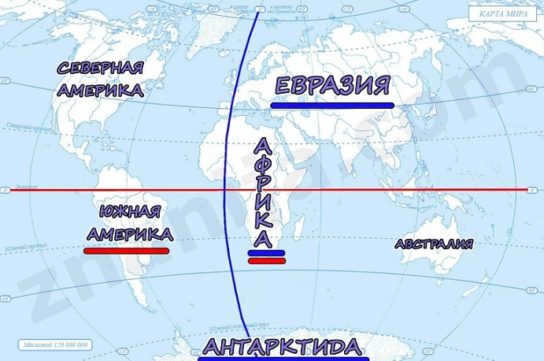
When it comes to the Pacific Ocean, the equator acts as a dividing line for multiple territorial seas:
- The boundary between Guinea and Palau;
- The boundary between Guinea and Micronesia;
- The boundary between Nauru and Kiribati (and Kiribati is the sole country in Polynesia whose territorial seas touch the equator).
Why is the equator necessary?
The equator serves several important functions. Firstly, it acts as a dividing line, separating the planet into two hemispheres – the Northern Hemisphere and the Southern Hemisphere. This division is crucial for understanding geographic latitude, with the equator serving as the zero latitude reference point. Furthermore, the equator provides a valuable tool for navigating the planet’s climatic zones.
When it comes to regions near the equator, they receive the highest amount of solar energy and rays. Conversely, areas farther away from the equator and closer to the poles receive significantly less sunlight. This disparity in sunlight plays a fundamental role in shaping the climate of these regions.
The equator line depicted on maps serves as a tool for scientists to perform the required computations, determining the precise positions of various objects and points by referencing the climate zones.
Equator Explained – educational video for children
Aside from Eratosthenes, various scientists throughout history have attempted to make their own discoveries and determine the shape and size of the Earth, ultimately calculating the distance to its center. One notable individual was the Dutchman Sibelius, who lived in the 17th century and possessed a more advanced device for that time called the theodolite. Prior to Sibelius, scientists in the 9th century also sought to determine the Earth’s size using degrees. However, these measurements were incredibly challenging and almost impossible to carry out due to obstacles such as mountains, rivers, lakes, and villages. In other words, conducting accurate linear measurements and calculating the planet’s size was nearly unattainable in rugged terrain. It was only in the 17th century that this problem was resolved with the invention of the triangulation method.
The technique is founded on constructing triangles and measuring the base of each triangle. In the 19th century, Russian scientists participated in determining the shape and size of the Earth. The investigation was conducted at the Pulkovo laboratory under the expert guidance of V. Y. Struve.
Video
Watch a fascinating experiment that demonstrates how Eratosthenes was able to calculate the Earth’s circumference.
The equator is an imaginary circular line that wraps around the entire Earth and intersects the Earth’s center. The equator line is perpendicular to our planet’s axis of rotation and is equidistant from both poles.
What is the Equator and why is it necessary?
The Equator is an imaginary line that serves important purposes for scientists. Although it only exists in imagination and on paper, the Equator, along with meridians, parallels, and other divisions of the Earth, enables calculations, navigation, and the determination of location.
By dividing the Earth into Northern and Southern hemispheres, the Equator acts as the starting point for geographic latitude, with a latitude of 0 degrees. This helps us understand the different climatic zones on our planet. The equatorial region receives the most sunlight, while areas closer to the poles receive less.
The equatorial region experiences perpetual summer, with consistently hot and highly humid air as a result of continuous evaporation. At the equator, the duration of day and night is always equal. The sun reaches its highest point directly overhead, known as the zenith, only at the equator and only twice a year during the equinoxes, which occur in most geographic regions of the Earth.
A total of 14 countries are crossed by the equator. Some cities that lie directly on this line include Macapa in Brazil, Quito in Ecuador, Nakuru and Kisumu in Kenya, Pontianak on Kalimantan Island in Indonesia, Mbandaka in the Republic of Congo, and Kampala, the capital of Uganda.
The longest parallel on Earth is known as the equator, which measures approximately 40,075 kilometers. Eratosthenes, an ancient Greek astronomer and mathematician, was the first person to make an estimation of the equator’s length. He achieved this by observing the time it took for the sun’s rays to reach the bottom of a deep well. This enabled him to calculate the Earth’s radius and, subsequently, the length of the equator using the formula for the circumference of a circle.
It is important to note that the Earth is not a perfect circle, resulting in slight variations in radius across different regions. For instance, the radius at the equator is approximately 6378.25 km, while at the poles it measures around 6356.86 km. Therefore, when solving problems involving the calculation of the equator’s length, a radius of 6371 km is typically used.
The length of the equator is a fundamental metric characteristic of our planet. It is utilized in calculations not only in the fields of geography and geodesy, but also in astronomy and astrology.
Geometry (derived from the Ancient Greek words Geo, meaning “earth,” and Metron, meaning “measurement”) originally referred to the measurement of the Earth. Nowadays, geometry has a broader scope, encompassing the study of shapes, sizes, relative positions in space, and properties of space. Geometry emerged independently in various early cultures as a practical discipline concerned with measurements of length, area, and volume, incorporating elements of formal mathematical science.
The origin of the meter
The meter was initially conceived as a segment that is one ten-millionth (1/10, 000000) of the distance between the equator and the North Pole, also known as a quadrant. To put it simply, a meter was defined as 1/10, 000000 of the distance from the equator to the North Pole, measured on the surface of the Earth along the Paris longitude.
Based on this definition, the circumference of a perfectly spherical Earth would be precisely 40,000, 000 meters (or 40000 km). However, due to the fact that the Earth is not a perfect sphere but rather an ellipsoid, the officially recognized value for the Earth’s circumference along the longitude is 40,007.86 kilometers.
Nautical mile
The nautical mile is derived from the circumference of planet Earth. By dividing the Earth’s circumference by 360 degrees and then dividing each degree by 60 minutes, we arrive at 21,600 minutes of arc.
1 nautical mile is equal to 1 minute of arc of the Earth’s circumference. This unit of measurement is universally used for air and sea transportation. Using the official data of Earth’s circumference, which is 40,007.86 km, we can calculate the value of nautical miles in kilometers: 1,852 kilometers (40,007.86 / 21,600).
Ancient measuring systems demonstrate that our ancestors possessed remarkable precision in determining the size of our planet…
The Earth’s air envelope, known as the atmosphere, extends up to 550 km in altitude. It is composed of several layers:
- The first layer is called the troposphere and it extends up to 12 km.
- Above the troposphere is the stratosphere, which spans from 12 to 50 kilometers.
- The mesosphere is located between 50 and 80 km.
- Next is the thermosphere, which ranges from 80 to 1000 km.
- The outermost layer is known as the exosphere.

The Earth’s atmosphere is the gas envelope that surrounds planet Earth. Credit: wallbox.ru
The characteristics of the different layers are not identical. The lower layers of the atmosphere are the most dense, and the density decreases with altitude. The troposphere accounts for nearly 80% of the total mass of the atmosphere and contains 99% of the Earth’s gaseous water. Its chemical composition includes the following gases:
- nitrogen (78%);
- oxygen (21%);
- the inert gas argon (1%);
- carbon dioxide or CO2;
- water vapor.
The stratosphere, the second layer of the atmosphere, contains the ozone layer, which serves as a shield against excessive ultraviolet radiation. As altitude increases, the temperature initially decreases, but then rises due to the ozone layer’s absorption properties. This layer is where airplanes typically fly.
Once the transition to the mesosphere occurs, temperatures begin to drop again, reaching as low as -80…-100 °C. Within this layer, silvery clouds composed of frozen water crystals form. Despite being the coldest atmospheric layer on Earth, the mesosphere is also where most meteorites disintegrate upon entry into our planet’s atmosphere.
The exosphere is primarily composed of the lightest gases, hydrogen and helium. It lacks defined boundaries and serves as a transitional region between Earth’s atmosphere and the vast expanse of outer space. Within this layer, particles can attain the necessary velocity to escape the gravitational pull of the planet and venture into the cosmic void. The ionosphere, which encompasses both the exosphere and the thermosphere, is the layer where air particles become ionized due to the influence of the solar wind.
Offspring of Pangea
Around 170 to 200 million years ago, Pangea underwent a mysterious division, resulting in the formation of two separate parts, which eventually broke apart into multiple tectonic plates. This monumental event led to the creation of continents and oceans, accompanied by immense geological turmoil that reshaped the entire Earth. Remnants of this magnificent process are evident in island arcs, rugged mountain ranges, and deep oceanic trenches. Although the continents continue to gradually approach each other, their movement is incredibly slow in comparison to their vast size, advancing only a few centimeters per year. Based on rough calculations, it is predicted that they will once again collide and form a supercontinent in 250 million years.
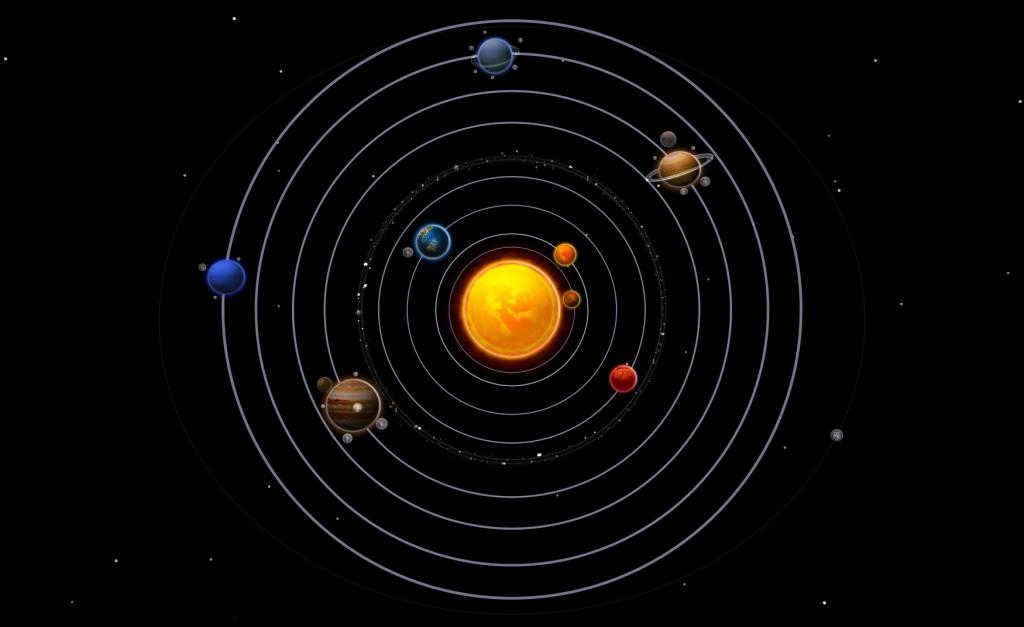
- Mercury
– Located 58 million kilometers away from the Sun. This planet, which is the smallest in the system, has an extremely thin atmosphere. As a result, the surface experiences drastic temperature changes, ranging from +430 °C to -190 °C. - Venus
– Positioned at a distance of 108 million kilometers. The atmosphere of Venus is ninety times denser than Earth’s. It acts as a greenhouse, causing the surface temperature to reach a scorching 460 °C. Due to this extreme heat, water cannot exist in a liquid state, rendering life impossible. - Earth
– Located 149.5 million kilometers away from the Sun. Earth provides ideal conditions for life to thrive. It has a larger mass and surface area compared to any other planet in the Earth group. - Mars
– Mars is located 228 million kilometers away from Earth. The atmosphere on Mars is 500 to 800 times less dense than Earth’s atmosphere. The surface of Mars is too cold to support life, with temperatures dropping to -100 °C at night.
Now let’s take a look at the gas giants in our solar system:
- Jupiter
– Jupiter is positioned 778 million kilometers away from Earth. It is the largest planet in our solar system, with a mass that is two and a half times greater than the combined mass of the other seven planets. Additionally, Jupiter’s surface area is almost 122 times larger than that of Earth. The composition of Jupiter is primarily helium and hydrogen. - Saturn
– Saturn is located 1.43 billion kilometers away from Earth. This planet is known for its stunning rings and has a density lower than that of water. - Uranus
– The average distance of Uranus from the Sun is approximately 2.88 billion kilometers. In the solar system, Uranus has the coldest surface temperature, dropping as low as -224 °C. - Neptune
– The average distance of Neptune from the Sun is approximately 4.5 billion kilometers. Being the farthest planet from the Sun, Neptune has an atmosphere primarily composed of hydrogen and helium with traces of methane. Similar to Uranus, Neptune experiences extremely cold temperatures, reaching below -200 °C.
Upon examining this data, one cannot help but be astounded by the fortuitous convergence of events that allowed for the existence of life on our planet. For years, both scientists and science fiction enthusiasts entertained the idea of extraterrestrial life on Venus and Mars. However, research conducted in recent decades has revealed that this is highly improbable. The climatic conditions and atmospheric composition on these neighboring celestial bodies are simply too inhospitable. They lack the essential presence of an ocean, which served as the cradle for Earth’s biosphere. Additionally, their feeble magnetic fields fail to provide adequate protection against the lethal radiation emitted by our sun.
Keep Going
We now have a precise understanding of the Earth’s shape, accurate to within a few centimeters. However, its height can vary by 10 to 15 km in either direction:
- The mean radius of the Earth is 6371 kilometers
- The geocentric mean varies by 11 km, with a range of 6368 km ± 11 km
- The Earth’s ellipsoid has semicontinental axes, with the equatorial axis measuring 6,378.1 km and the polar axis measuring 6,356.7 km
- The radii of curvature of the Earth’s continents vary from 6330 km at the equator to 6400 km at the poles
- Therefore, our representation of the Earth as a “globe” is accurate to within 0.5%.
Many people are unaware that the Earth’s radius not only changes due to its flattening, but there is also a “latitude problem”: the geographic and geocentric latitudes differ by 0.19° or 22 kilometers. This means that when it comes to land surveying, using a bullet that fits the local variations of the Earth’s shape is the most accurate method. There are over a hundred different ellipsoids used worldwide to approximate the Earth’s shape. When indicating the geographical coordinates of a place, it is always in reference to a specific geodetic coordinate system.
This implies that the plumb line, which is believed to extend beneath our feet, traverses through the Earth’s core at a distance of up to 20 km. Disciplines such as earth measurements, geophysics, and satellite geodesy are required to grapple with the pertinent data on a daily basis.
Additional Information [ edit ]
- For further details, refer to the Drawing of the Earth, geoid, and Earth tide.
- The geoid lacks a singular center; it varies based on local geodetic conditions.
- The radius value is dependent on the latitude when using the ellipsoid model and also has some dependence on the geoid.
- This can be deduced from the second rule of definition by the International Astronomical Union: the shape of a planet is determined by the balance between gravitational and centrifugal forces in hydrostatic equilibrium.
- When considering east-west directions, it’s important to note that they can be misleading. For example, Point B may appear to the east of Point A, but it can actually be closer to the equator than Point A. Consequently, the observed curvature is less than that of a circle with constant latitude, except at the equator. For the purpose of this discussion, the terms West and East can be interchanged.
- N is defined as the radius of curvature in a plane that is perpendicular to both the surface of the ellipsoid and the meridian passing through the specific point of interest.
The size of the Earth and various astronomical measurements
During our time in school, we were exposed to a wide range of subjects, such as physics, chemistry, biology, mathematics, and even astronomy. Astronomy, in particular, is a fascinating field of study that delves into various cosmic measurements, including the distance between the Sun and our planet, the size of the Earth, the weight of the moon, and many others. Furthermore, it explores universal phenomena like black holes, stargazing, and eclipses, which captivate our imagination.

We can all agree that the information about our surroundings is incredibly important and informative. However, if someone were to ask us about the exact diameter of planet Earth, most of us would struggle to provide a correct answer. Regrettably, much of what we learn in school tends to fade from our memory over time if we don’t actively maintain that knowledge. Fear not, for this article aims to refresh our understanding of some “celestial” facts.
It is widely believed that the measurement of our planet’s circumference was undertaken well before the Common Era. The renowned ancient scientist-astronomer Eratosthenes, utilizing the distances between cities and the angle of the sun’s rays, successfully computed the length of the Earth’s circumference, subsequently determining its radius and diameter. Thus, the average measurement of this value stands at approximately 12,756 kilometers. It is important to note the term “average” is employed here due to the fact that the Earth does not possess the shape of a perfect sphere (although it is not an ellipse, a subject that garnered significant attention at one point).
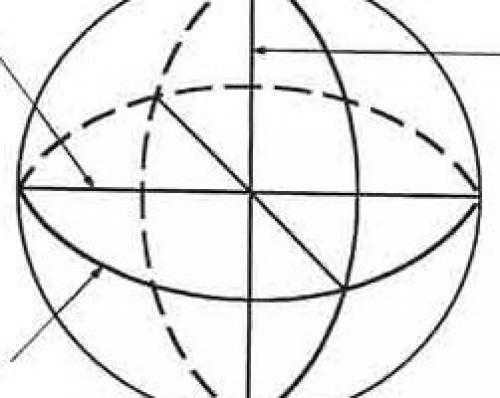
The Earth has a unique form that is stretched towards the poles, now commonly referred to as a geoid. Due to this “distortion”, the Earth’s diameter at the equator is different from the corresponding measurement along the prime meridian (the latter being slightly larger).
Additionally, the blue planet has other significant characteristics.
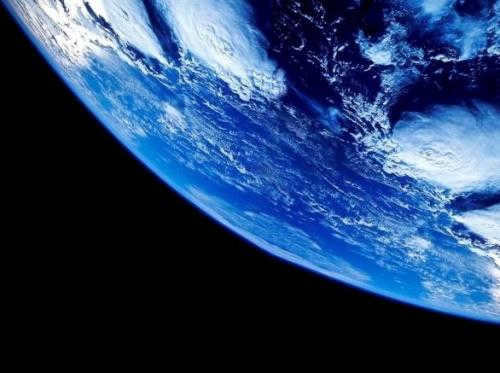
Undoubtedly, the planet Earth is currently the sole location in the vast expanse of the universe that has been extensively explored and analyzed by local scientists. It is the only known place where life has thrived for nearly four billion years, encompassing a diverse array of organisms that can be found both on land and in the vast expanses of water. In fact, water covers more than seventy percent of the Earth’s surface, making it a truly unique and remarkable planet. However, it is not just the presence of living organisms that sets Earth apart from other celestial bodies. Our planet also displays its own form of life through the dynamic movement of tectonic plates, resulting in volcanic eruptions and seismic activities ranging from mild tremors to powerful earthquakes. These geological phenomena serve as a testament to the ever-evolving nature of our planet, constantly shaping and transforming the Earth’s surface. It is truly awe-inspiring to consider that our home, the living blue planet, continues to hold countless surprises and mysteries that are yet to be discovered.
What is the method for determining the size of our planet?
We are fortunate that our planet is not flat like a pancake, but rather spherical in shape. This is particularly advantageous when it comes to determining the size of the Earth, as measuring its length and width would be a difficult and laborious task. If the Earth were flat, we would have had to physically measure its dimensions, which would have required significant resources and technical capabilities. It is likely that we would not have been able to accurately determine the true dimensions of the Earth until the invention of the steam engine.
However, thanks to the fact that our planet is spherical, the ancient Greek geographer and scientist Eratosthenes was able to measure the Earth’s diameter and circumference without even leaving his home. This remarkable feat was accomplished long before the first hot air balloon took flight.

Eratosthenes, hailing from Cyrene, achieved such remarkable precision in measuring the Earth’s size that his findings were met with skepticism!
The reason for this doubt lies in the fact that certain phenomena that occur on a spherical Earth are directly related to its size. Take, for instance, the position of constellations in the sky. Depending on the observer’s location, these positions may differ ever so slightly. This observation leads one to conclude that our planet, while vast, is finite and can indeed be measured.
Consider for yourself: if the dimensions of the globe were exceedingly vast, the indications of its roundness would be subtly minuscule. The sight of the celestial sky while moving a few hundred kilometers to the north or south would remain virtually unchanged, vessels would vanish from sight before their hull was concealed behind the horizon, the edge of the Earth’s shadow on the Moon would appear not as a semicircle but as a straight line – so slight would be its curvature.
However, how was it feasible to accurately ascertain the magnitude of the planet, without having the opportunity to ascend into space or even simply – to embark on a journey around the world? Lengthy centuries of observation preceded it.
History
From ancient times to the era of Columbus
The concept that the Earth has a spherical shape can be traced back to as early as 600 BC. In ancient Greek philosophy (Thales of Miletus, Anaximander) and around the 4th century BC, Aristotle provided three astronomical pieces of evidence to support this notion.
Eratosthenes, the inventor of the method of degree measurements, was the first to determine the length of the Earth’s circumference around 240 BC. He accomplished this by comparing the angles of the Sun’s highest point in Egypt between Alexandria and Siena (now Aswan), which differed by 1/50th of a full circle. From this, he deduced that the Earth’s circumference was 50 times the distance between Alexandria and Aswan, which, in today’s units, is 835 km multiplied by 50, resulting in 41,750 km. The radius can be calculated from the circumference, and Eratosthenes did so in stages. The unit of length used in his calculations is not significant for the accuracy of his determination of the Earth’s radius. Ultimately, Eratosthenes arrived at a radius of approximately 6,645 km, which is 4.2 percent higher than the current value.
During the early Middle Ages, the Arabs established that a degree corresponds to 56 2/3 Arabian miles, which is roughly equal to 2,000 meters. This calculation resulted in the Earth’s radius being estimated at R = 6,500 km, deviating about 2 percent from the current value. In 1023, the mathematician Al-Biruni devised a novel measurement method and determined the globe’s radius to be 6,339.6 kilometers.
By the 15th century, Europeans were aware of these values, although they sometimes wrongly attributed the Arabic measurements to the Italian mile, which was believed to be 25 percent shorter. Based on this misconception and an overestimation of the size of Asia, Columbus mistakenly concluded that East Asia could be reached within a few weeks by sailing westward.
In August 1519, Ferdinand Magellan embarked on his journey to sail around the world. It wasn’t until the fleet reached the Philippines in 1520, firmly placing them in Asian waters, that the undeniable evidence of the Earth’s spherical shape was finally obtained. This discovery also led to the correct estimation of the Earth’s circumference, which had previously been greatly underestimated.
The precise measurement of the Earth’s size was only known with a certain level of accuracy towards the end of the age of exploration. During the 17th and 18th centuries, French scientists attempted to determine the Earth’s deviation from a perfect sphere by measuring the degree of curvature over long distances. However, this method was not completely reliable and sometimes resulted in an exaggerated estimate of the Earth’s radius. In contrast, Isaac Newton proposed that the Earth would flatten slightly due to centrifugal force caused by its rotation.
This problem was solved by the French Academy’s measurement of the Earth during their two expeditions to Lapland and Peru (from to 1741). These expeditions were also used to determine the meter (which is the estimated circumference of the Earth above the poles = 40,000 km) and achieved an accuracy of 0.02 percent or 1.5 km (the meridian quadrant = 10,002,250 m, average Earth radius R = 6,369.6 km).
Since then, the precision of determining the mathematical shape of the Earth has doubled every 50 years. By around 1965, satellite geodesy significantly improved accuracy to 20 meters and is now approaching the centimeter range. Newly developed satellites that measure gradients, such as GRACE () and GOCE, even focus on the changes in the Earth’s shape, which are believed to be in the range of a few millimeters per year.
Global radii[ edit ]
The Earth can be represented as a sphere in various ways. This section describes common methods. The measurements and dimensions used here are based on the Earth derived from the WGS-84 ellipsoid, specifically:
Equatorial radius a = ( +6 +378 0.1370 km ) Polar radius b = ( 6,356 .7523 km )
The sphere is a rough approximation of the spheroid, which in turn is an approximation of the geoid. The measurements are given in kilometers, which is appropriate for geodesy.
Nominal radius
In the field of astronomy, the International Astronomical Union commonly refers to the nominal equatorial radius of the Earth as 6,378.1 kilometers (3,963.2 miles). 3 The nominal polar radius of the Earth is officially defined as 6,356.8 km (3,949.9 miles). These numerical values are representative of the Earth’s size under the condition of zero Earth tide. The equatorial radius is typically used as the default value unless a polar radius is specifically required. 4
The nominal radius is widely used as a standard unit of length within the field of astronomy. (The notations are designed to be easily applicable to other celestial bodies, such as the nominal polar radius of Jupiter.)
RpJN>_ <\mathrm >^ <\mathrm >>
Average size
The equatorial ( a ), polar ( b ) and average sizes of the Earth as defined in the 1984 edition of the World Geodetic System (not to scale)
In the field of geophysics, the International Union of Geodesy and Geophysics (IUGG) defines the average size of the Earth (represented by R 1 ) as
The factor of two takes into account the biaxial symmetry of the Earth’s spheroid, which is a specialized form of the triaxial ellipsoid. For the Earth, the average size is 6371.0088 kilometers (3958.7613 miles).
The authalic radius of the Earth (also known as “equal area”) is the radius of an imaginary perfect sphere that has the same surface area as the reference ellipsoid. The International Geodetic and Geophysical Society (IGGS) designates the authalic radius as R2.
A mathematical solution exists for the spheroid:
where e2 = a2 – b2/a2 and represents the surface area of the spheroid.
For the Earth, the authalic radius is 6371.0072 km (3958.7603 miles).
Volumetric radius
Another spherical model is characterized by the volumetric radius of the Earth, which represents the radius of a sphere with a volume equivalent to that of the ellipsoid. The IGGS refers to this volumetric radius as R3.
For Earth, the volumetric radius measures 6,371,0008 km (3,958,7564 miles).
Rectification radius
There is another global radius known as the rectification radius of the Earth. It refers to the radius of a sphere that has a circumference equal to the perimeter of the ellipse formed by any polar cross section of the ellipsoid. In order to calculate this radius, both the polar and equatorial radii need to be taken into account.
The rectification radius is essentially the same as the meridional mean, which is calculated as the average of M.
When the limits of integration are set as [0, π/2], the integrals for both the rectification radius and the mean radius yield the same result, which is approximately 6,367.4491 km (3,956.5494 miles) for the Earth.
The semi-cubic mean of the two axes is a good approximation for the meridional mean, although a citation is needed to support this claim.
This approximation differs from the exact result by less than 1 μm (4 × 10^-5 in), which is the average of the two axes.
about 6367.445 km (3956.547 mi), can also be utilized.
Global average radius of curvature
For the WGS 84 ellipsoid, the mean curvature is 6370.994 km (3958.752 mi). citation needed
So, let’s talk about the measurements of Earth’s diameter and equator. Considering the fact that Earth’s shape is not perfectly spherical, the equator is generally regarded as a circle. At the equator, the diameter measures 12,756 kilometers, while at the poles, it is slightly smaller – 43 kilometers. For instance, in 2007, it was discovered that since 2000, the planet’s diameter has decreased by five millimeters.
The circumference of the Earth at the equator is 40000 kilometers, but how many kilometers would it be if measured from pole to pole?
The bulge around the equator is created by the Earth’s rotation. Assuming the Earth is a spherical shape and its circumference is 360 degrees, we can calculate the distance (chord) between two points one degree apart and multiply it by 360. It may seem simple, but the actual length of the equator is determined by scientists using the formula 2πR. Despite the Earth being more elliptical in shape, resembling a flattened ball at the poles, this formula is still used.
How long is the Earth’s equator?
The Earth’s equator measures 40,075 kilometers in length. It acts as a dividing line between the Northern and Southern hemispheres and serves as the reference point for measuring geographic latitude. The equator is an imaginary line that runs along the Earth’s surface, passing through its center and perpendicular to the planet’s axis of rotation. Despite reaching the boundary between the two hemispheres, the exact length of the equator remained unknown. However, a scientist was able to calculate the radius of the Earth by measuring the time it took for the sun’s rays to reach the bottom of a well, thus determining the length of the equator.
How was the circumference of the Earth in kilometers calculated and what is the value? What is the length of the Earth’s circumference along the equatorial line or meridian? The equatorial line is a circular line that goes around the planet and passes through its center. It is perpendicular to the Earth’s axis of rotation. A scientist measured the angle and discovered that it is 1/50th of the entire circle, which is equal to 360 degrees. It was determined that the length of a degree is smaller at the equator. As a result, it was found that the polar circumference of the Earth is 21.4 kilometers shorter than the circumference at the equator.
What is the measurement of the Earth’s circumference?
Can anyone recall the exact number of kilometers that make up the Earth’s circumference at the equator? Does anyone know the history behind the first measurement of the Earth’s circumference? By using astronomical instruments to measure this angle, scientists discovered that it is equal to 1/50th of the total circumference. Therefore, knowing the chord of a 1-degree angle is sufficient to calculate the distance between two points on the Earth’s surface that lie on rays with a 1-degree angular separation.
The equator is a line that is perpendicular to the Earth’s axis of rotation and is equidistant from both poles. This enabled Eratosthenes to determine the Earth’s radius and the length of the equator using the formula for the circumference of a circle. Additionally, in other writings, Eratosthenes calculated the equator by measuring the angle of the shadow cast when the Sun illuminated the bottom of a well! It is important to note that the equator, which is a line that traverses the Earth’s surface, does not pass through the center of the Earth, as you have incorrectly stated.
Eratosthenes supposedly measured angles with the precision of angular seconds, and the discrepancy in latitudes between Alexandria and him was 7° 6.7′, which is equivalent to 426.7 nautical miles (angular minutes). It remains unclear what method Eratosthenes used to measure distances. The first angle is based on the arc formed by the shadow of the gnomon and its base, while the second angle is based on the arc drawn from Siena to Alexandria, centered on the Earth’s center. These arcs are similar because equal angles are based on them. Furthermore, the relationship between the arc on the bowl and its circumference is analogous to the relationship between the arc from Siena to Alexandria and the Earth’s circumference.
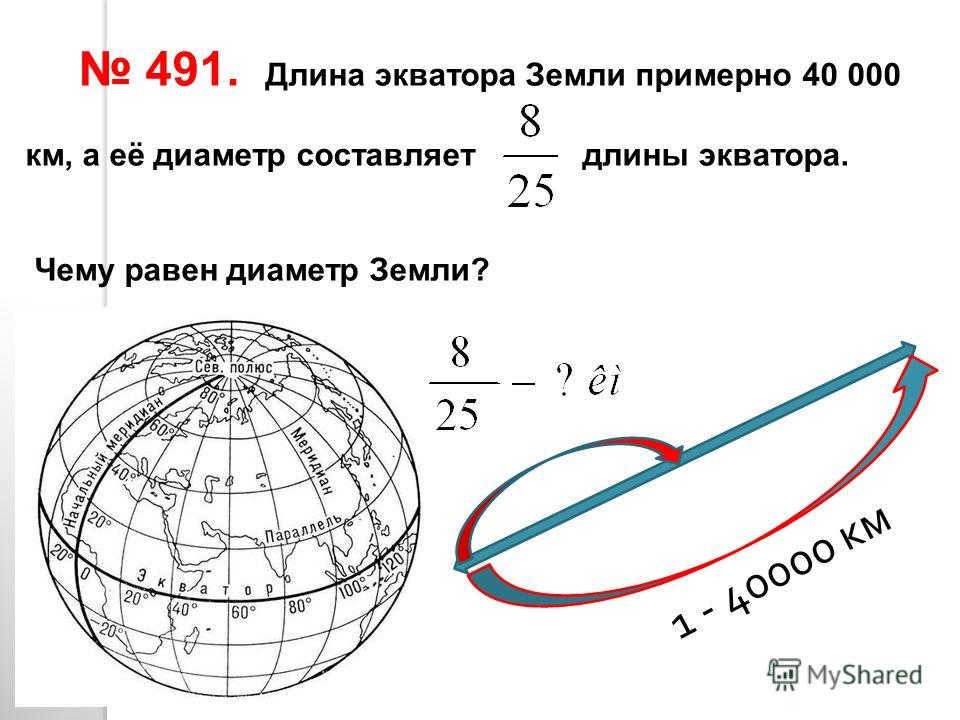
Calculating the Earth’s circumference
Here’s a straightforward method for calculating the circumference (and diameter) of the Earth that was likely employed by ancient astronomers. An optimal choice would be a Star in close proximity to the celestial axis of the North Pole (which denotes the Earth’s axis of rotation). The angular diameter of both the Moon and the Sun is approximately 0.5 degrees. If one of our astronomers were to make this measurement from a location at point(A) near Giza (30 0 C), the star Mizar would have been observed to be approximately 41 degrees above the local horizon.
More recently, in 1862, the depth of the Earth’s thickness was determined by the German scientist P. Ioseliani to be 4536.8 km, which is 11/2 times smaller than the correct value. It may be difficult to believe, but a brochure titled “The Earth is motionless, a popular lecture proving that the globe does not rotate about its axis or around the Sun” was published in St. Petersburg in 1876. In 1841, the German astronomer F. Bessel used degree measurements to calculate the Earth’s radius and its compression at the poles, obtaining figures that characterize the main elements of the Earth’s ellipsoid. It is also important to consider that the northern and southern hemispheres are not completely symmetrical with respect to the equator’s plane, as demonstrated by the Russian scientist A. A. Ivanov.
It is only exceeded in size by Mercury, Mars, and Pluto. When the region surrounding the North Pole is exposed to the Sun, it signifies summer in the Northern Hemisphere and winter in the Southern Hemisphere. Conversely, when the region surrounding the South Pole is exposed to the Sun, it signifies the opposite. A meridian, which is a semi-circle, corresponds to _______ degrees and ________”, under the category of “geography”.
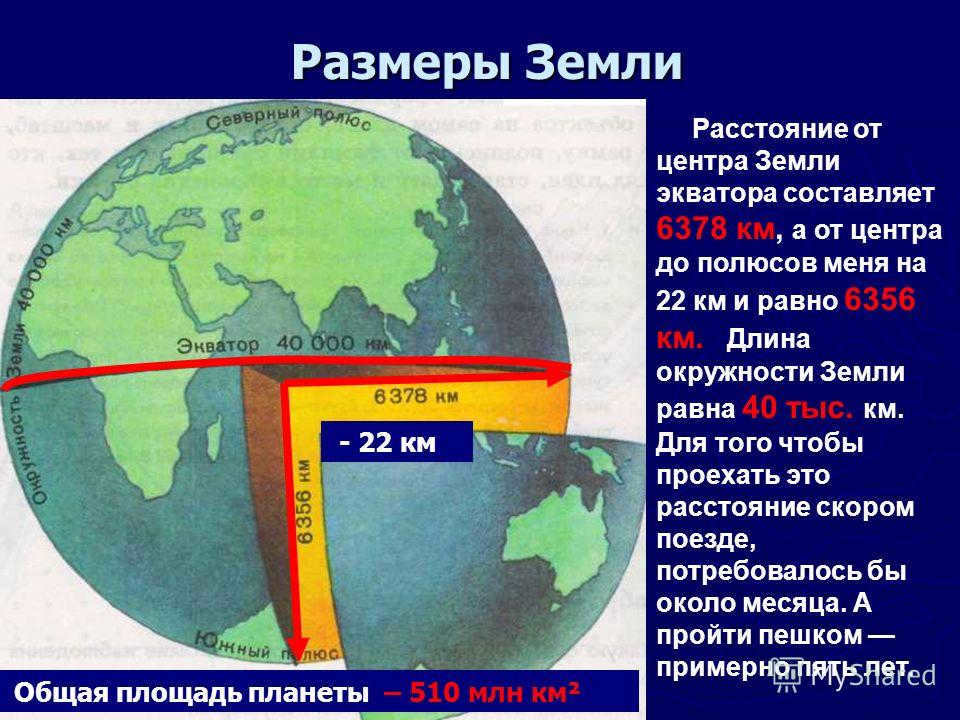
Through conducting extensive research, Eratosthenes was able to estimate the Earth’s radius and subsequently determine the length of the equator. In order to calculate the equator, it is necessary to have knowledge of the planet’s radius. At the equator, the latitude is zero. The length of the equator is a fundamental characteristic of any celestial body.
In a simplified model, the Earth’s magnetic field is considered to be a dipole, with its poles positioned near the geographic poles of the planet.
21.3 kilometers is the distance between the equator and the center of the Earth compared to its poles. Due to the Earth’s rotation, the poles are flattened by 1/298 of the diameter. At a height of 35,786 kilometers above the equator, the geostationary orbit is where communication satellites “hang”. A signal traveling at the speed of light can make a round trip in just a quarter of a second.
Throughout the year, the height of the Sun above the horizon changes due to the tilt of the Earth’s axis. The radius of Hill’s sphere, which represents the sphere of influence of Earth’s gravity, is approximately 1.5 million kilometers. This is the maximum distance at which the Earth’s gravity has a greater influence than the gravity of other planets and the Sun.
Eratosthenes utilized a sundial called the scaphis to determine the zenith distance of the Sun, serving as an angular measuring instrument. The Sun’s zenith distance is recorded as 47 degrees and 42 minutes.
In simpler terms, a meter was established as 1/10,000,000 of the distance from the Earth’s equator to the North Pole, measured on the surface of the Earth’s ellipsoid through the longitude of Paris.
The Earth’s round shape is widely known. However, what other information do we possess regarding its dimensions and form? Can any of us recall the number of kilometers that make up the Earth’s equatorial circumference? Or the meridional circumference? And who is aware of the initial method and time of measuring the Earth’s circumference? These details, nonetheless, hold great fascination.
Every year, scientific observations were carried out to measure this angle using astronomical instruments. The researcher discovered that this angle is equivalent to 1/50th of a complete circle.
It is widely known that a complete circle is equal to 360 degrees. Therefore, it is sufficient to determine the chord of a 1-degree angle (which is the distance between two points on the Earth’s surface that are separated by an angular distance of 1 degree). The obtained value should then be multiplied by 360.
To calculate the length of the chord, Eratosthenes took the distance between the cities of Alexandria and Siena (5,000 Egyptian stadia) and assumed that these cities are located on the same meridian. He performed the necessary calculations and referred to the resulting figure as the circumference of the Earth, which amounted to 252,000 Egyptian stadia.
At that time, this measurement was extremely accurate as there were no reliable techniques for determining the distance between cities. The distance from Siena to Alexandria was measured based on the speed of a camel caravan.
Later on, scientists from various countries conducted numerous measurements to refine the Earth’s circumference. In the 17th century, a Dutch scientist named Sibelius devised a method of measuring distances using the first theodolites – specialized surveying instruments. This technique, known as triangulation, involves constructing numerous triangles and measuring the base of each one.
Triangulation continues to be used today, with the Earth’s surface effectively divided and delineated into large triangles.
Russian scientists have also made contributions to this research. In the 19th century, V. Ya. Я. Struve measured the circumference of the Earth.
Up until the middle of the 17th century, the Earth was believed to be a perfectly spherical shape. However, over time, evidence started to accumulate suggesting that the Earth’s gravitational force decreased from the equator to the poles. This sparked intense debates among scientists as they tried to determine the reasons behind this phenomenon. The most widely accepted theory was that the Earth was compressed at the poles.
In order to test this hypothesis, the French Academy organized two separate expeditions in 1735 and 1736. These expeditions measured the length of both the equatorial and polar degrees, one in Peru and the other in Lapland. The results showed that the degree was actually shorter at the equator!
Following this, subsequent measurements have confirmed that the polar circumference of the Earth is 21.4 kilometers shorter than the equatorial circumference.
Using the latest research methods and modern instruments, highly accurate measurements have been conducted. Soviet scientists Izotov A. A. and Krasovsky F. N. have obtained data in our country. According to their studies, the equatorial circumference of our planet is 40075.7 kilometers, while the meridian circumference is 40008.55 km. The equatorial radius of the globe, also known as the major semi-major axis, is 6378245 meters, and the polar radius, also known as the minor semi-major axis, is 6356863 meters.
There are 510 million square kilometers of Earth’s surface, with only 29% being land. The Earth’s “ball” has a volume of 1083 billion cubic kilometers. The mass of our planet is approximately 6X10^21 tons, with water resources making up about 7% of that.
It is common knowledge that the Earth is a spherical shape. However, not many people know the exact dimensions of the planet. What is the circumference of the Earth along the equator or the meridian? What is the diameter of the Earth? Let’s delve into these questions in great detail.
First and foremost, let’s familiarize ourselves with the fundamental concepts that we will encounter while exploring the length of the Earth’s circumference.
What is known as the equator? It is a circular line that encircles the globe and runs through its very center. The equator is at a right angle to the Earth’s rotational axis. It is equidistant from both poles. The equator divides the globe into two halves, known as the Northern and Southern hemispheres. It has a significant impact on the planet’s climate zones. The closer one is to the equator, the warmer the climate, as these regions receive more sunlight.
What are meridians? Meridians are defined as lines that divide the entire globe. There are a total of 360 meridians, meaning that each fraction between them is equivalent to one degree. These meridians extend from the North Pole to the South Pole. The main purpose of meridians is to determine geographic longitude. The counting of meridians begins at the prime meridian, also known as the Greenwich meridian due to its path through the Greenwich Observatory in England. Longitude is classified as either east or west, depending on the direction in which it is counted.
The measurement of the Earth’s circumference was initially carried out in ancient Greece. This task was undertaken by the mathematician Eratosthenes, who hailed from the city of Siena. During that era, it was already common knowledge that the Earth possessed a spherical form. Eratosthenes carefully studied the movement of the Sun and made an intriguing observation: when observed from Siena, the Sun would be positioned directly at the zenith, whereas in Alexandria, it would deviate at an angle.
These measurements were conducted by Eratosthenes during the summer solstice. The scientist measured the angle and determined that it was 1/50th of a complete circle, which is equal to 360 degrees. Eratosthenes then used the chord of a one-degree angle, multiplied it by 360, and applied it as the length of the chord between two cities, Siena and Alexandria. He assumed that these cities were on the same meridian and calculated the figure to be 252 thousand stadia. This number represented the circumference of the Earth.
During that time, these measurements were significant as there was no other method available to measure the Earth’s circumference with greater precision. Modern scientists acknowledge that Eratosthenes’ calculations were remarkably accurate, despite the fact that:
- the cities of Siena and Alexandria are not on the same meridian;
- The ancient scientist calculated the figure based on the duration of the camels’ journey, taking into account that they did not travel in a perfectly straight line;
- The instrument used by the scientist to measure angles remains unknown;
- It is unclear what Eratosthenes utilized to measure the stadia.
However, researchers continue to uphold the belief in the precision and distinctiveness of Eratosthenes’ method, which allowed for the first measurement of the Earth’s diameter.
In the Middle Ages.
During the Middle Ages, a Dutch scientist named Sibelius came up with a groundbreaking approach for calculating distances using theodolites, which are unique tools designed for measuring angles in geodesy. Known as Sibelius’ triangulation method, it involved the construction of triangles and the measurement of their bases.
Even to this day, triangulation remains a widely used technique. Modern scientists have divided the entire surface of the Earth into triangular regions as a convention.
Russian research
In the 19th century, scientists from Russia also made significant contributions to the study of measuring the length of the equator. Their research took place at the Pulkovo Observatory and was led by V. Ya Struve.
Prior to this, it was commonly believed that the Earth had an ideal spherical shape. However, as more evidence accumulated, it became clear that the Earth’s gravitational force decreased from the equator to the poles. Scientists embarked on a quest to explain this phenomenon. Several theories were proposed, with the most widely accepted one being the theory of Earth compression from both poles.
Currently, extensive and precise research has confirmed that the Earth’s circumference along the equator measures 40075.7 kilometers, while along the meridian it measures 40008.55 kilometers.
- The Earth’s major semi-major axis (the radius of the planet along the equator) is 6378245 meters;
- the polar radius, also known as the small semi-major axis, measures 6356863 meters.
Scientists have conducted calculations to determine the Earth’s surface area, resulting in a measurement of 510 million square kilometers. The land area accounts for 29% of this total. The Earth’s volume is estimated to be 1083 billion cubic kilometers. Its mass is approximately 6×10^21 tons, with water making up 7% of this value.
Video
Observe a fascinating experiment showcasing Eratosthenes’ ingenious method for calculating the Earth’s circumference.
If your question remains unanswered, propose a topic to the authors.
Moreover, the meridians are accurately determined. Thankfully, scientific progress has advanced to the point where obtaining the fundamental parameters of any celestial body is no longer arduous. Nevertheless, history is replete with intriguing anecdotes about the initial groundbreaking discoveries. Specifically, let us delve into the tale of how humanity first ascertained the Earth’s average radius to be 6371 kilometers.
Who can be credited as the pioneer of these calculations?
Many discoveries have been made thanks to a great sense of curiosity and inquisitiveness. These qualities have always been inherent in humans, and it would be unfair to say that the ancient Greek scholar Eratosthenes of Cyrenaica lacked them. Eratosthenes, who was known for his talents in mathematics, geography, astronomy, and poetry, was also the first person to determine the radius of the Earth. This groundbreaking discovery took place around 240 BC. One day, while working in the Library of Alexandria, Eratosthenes stumbled upon a papyrus that mentioned an intriguing observation made by the Egyptians. According to the document, in the southern part of Egypt, specifically in Siena (now known as Aswan), on June 21st at noon, a vertically placed pole would no longer cast a shadow, and the sun’s rays would reach the bottom of the deepest wells. In other words, the sun would be directly overhead. Curious about this phenomenon, Eratosthenes decided to test it in Alexandria. He patiently waited for June 21st and then conducted a similar experiment using a pole.
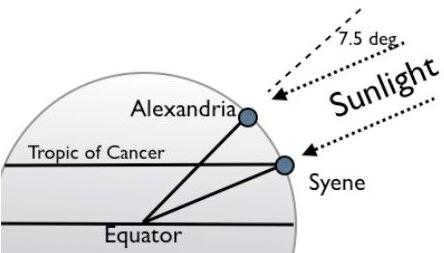
Although scientists now have very precise measurements of the average equatorial radius of the Earth (6378.137 km), the orbit radius, the distance to the Sun, and other parameters of our planet, they are not rushing to fully transition to the exploration of outer space.
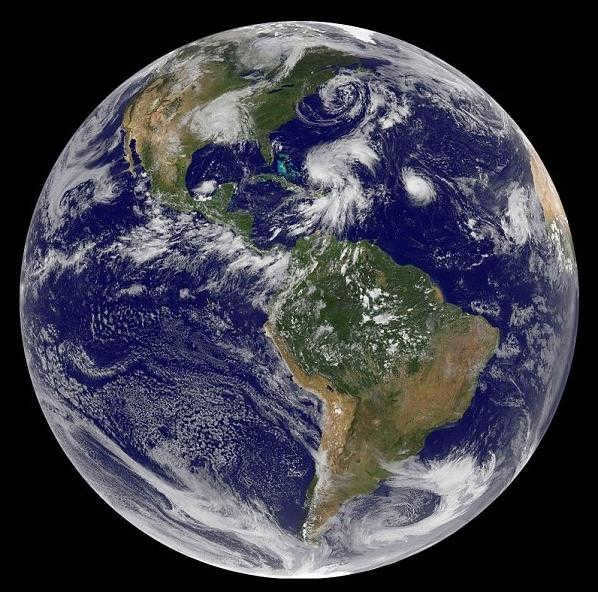
During the 19th century, a fascinating theory emerged about the factors that influenced the creation of mountains and oceans. Scientists proposed that the shifting of tectonic plates caused a change in the Earth’s orbit radius, which in turn led to the formation of these geographical features. For a long time, many researchers supported this viewpoint. However, in 2011, a new study conducted by experts from the Jet Propulsion Laboratory completely disproved this hypothesis. Using satellite data, the experts developed a detailed model of the movement of geographical objects on the Earth’s surface. They discovered that even if the radius of our planet does change, the rate of change is less than 1/10 millimeter per year.
The Earth’s poles, which are the northernmost and southernmost points on the planet, play a significant role in navigation and exploration. The equator, on the other hand, is a crucial line that divides the Earth into the Northern Hemisphere and the Southern Hemisphere. It serves as a starting point for studying the planet’s features based on latitude, as its latitude is 0°. All other parallels of latitude, whether they are north or south of the poles, are measured from the equator. Additionally, the equator is also important for navigational purposes, and it is used as a reference point for measurements of longitude. The line of longitude that corresponds to the equator is known as the Greenwich (zero) meridian.
Geography of the Earth’s Equator
The Earth’s equator is a unique line on the planet’s surface known as a great circle. A great circle is defined as any circle drawn on a sphere or spheroid, such as the Earth, with a center that includes the center of that sphere. Thus, the equator is classified as a great circle because it passes through the Earth’s center and divides it into two equal halves. In contrast, other lines of latitude, both north and south of the equator, known as parallels, are not considered great circles. This is because they progressively narrow as they approach the poles and are not centered on the Earth.
The parallels, although also great circles of the Earth, have a smaller circumference compared to the equator due to the flattened shape of the planet.
Due to the effects of gravity and rotation, the shape of our planet is an ellipsoid, which means it is slightly flattened at the poles and bulging at the equator. This results in the equatorial diameter being larger at 42.7 kilometers (26.5 miles) compared to the polar diameter of 12,713.5 kilometers (7,899.8 miles). The Earth’s circumference also follows this pattern, with a larger measurement at the equator due to the equatorial bulge. For instance, at the poles, the circumference is 40,008 km (24,859.82 miles), whereas at the equator it measures 40,075.16 km (24,901.55 miles).
Moreover, due to the fact that the Earth is an oblate spheroid, its rotational velocity varies across different latitudes. The highest linear speed of rotation is observed at the equator. This is because the equatorial circumference of the planet measures approximately 40,000 km or 24,000 miles (for simplicity), and the Earth completes one full rotation on its axis in 24 hours. Therefore, by dividing the equatorial circumference of 40,000 km (24,000 miles) by 24 hours, we can determine that the linear rate of rotation at the equator is 1,670 km (1,000 miles) per hour. However, as we move towards the north or south poles from the equator, the circumference of the Earth gradually decreases, resulting in a decrease in the linear speed of rotation as well.
Climate and the equator
The equator plays a crucial role in determining the climate of different regions on Earth. The equator is an imaginary line that divides the Earth into the Northern Hemisphere and the Southern Hemisphere. It is the point on the Earth’s surface where the sun is directly overhead at noon on the equinoxes.
Due to the position of the equator, the areas near it experience a tropical climate. This means that they have high temperatures throughout the year and a relatively high amount of rainfall. The equator receives the most direct sunlight, which leads to warm temperatures. The warm air rises, causing rainfall in these regions.
In contrast, areas farther away from the equator experience different climates. As one moves away from the equator towards the poles, the climate becomes cooler. This is because sunlight is spread over a larger area, resulting in lower temperatures. Additionally, the angle at which the sunlight reaches the Earth’s surface becomes more oblique, leading to less intense heat.
The equator also influences the distribution of seasons. In the tropics, near the equator, there is no distinct change in seasons. These areas experience a wet and dry season instead. As one moves away from the equator towards the poles, the seasons become more pronounced, with distinct changes in temperature and weather patterns.
Overall, the equator plays a significant role in determining the climate of different regions on Earth. Its position influences temperature, rainfall, and the distribution of seasons. Understanding the relationship between the equator and climate is crucial for studying and predicting weather patterns.
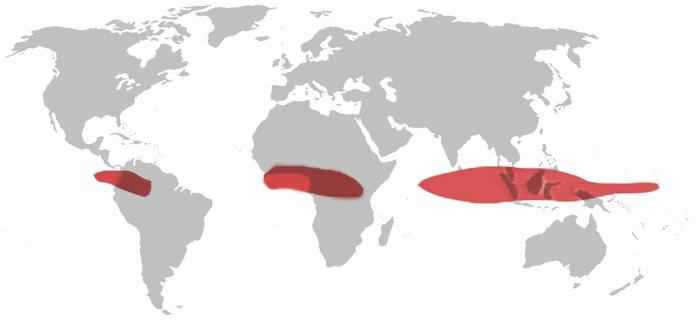
The climate belt that encircles the Earth along the equator is unique in both its physical environment and geographic significance. Its most notable distinction, however, lies in its climatic conditions. Throughout the year, the equator experiences consistent climate patterns, with a prevalence of warm, humid or warm and arid climates. Additionally, the equatorial region is marked by high levels of humidity, a direct result of receiving the highest amount of solar radiation.
Countries located on the equator
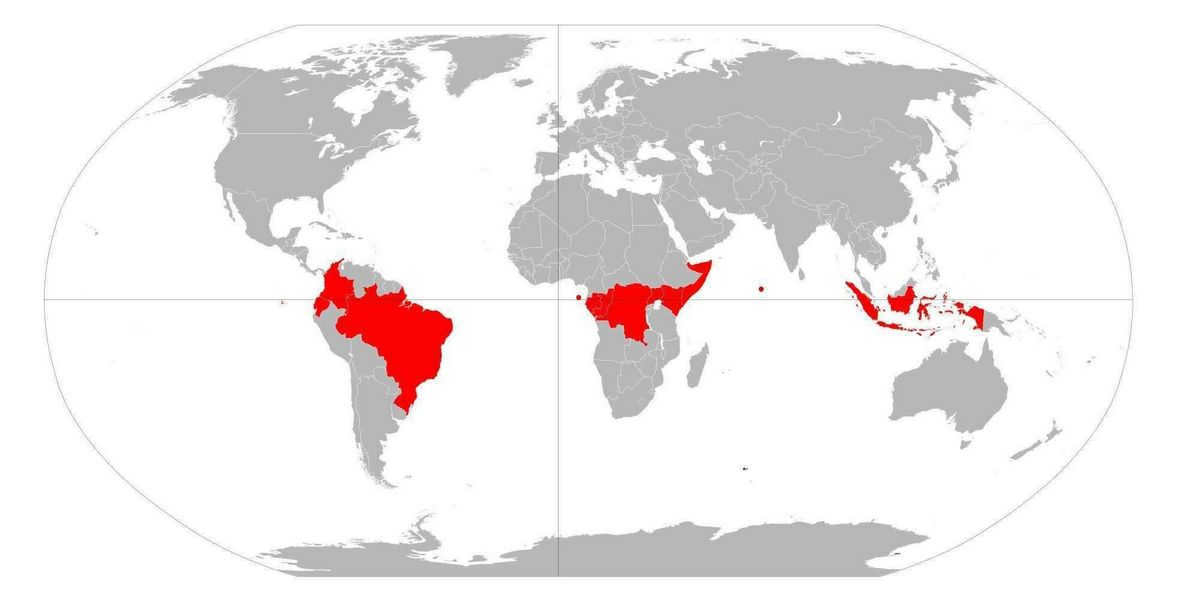
Aside from dense rainforests, the equator line intersects the land and waters of thirteen countries. While some of these countries have low populations, others, like Ecuador, boast large populations and major cities located directly on the equator. For instance, Quito, the capital of Ecuador, sits within one kilometer of the Equator, and the city proudly showcases a museum and monument at its center to mark this significant location.
Besides Ecuador, the equator line traverses through the territories of the following countries: Republic of Congo, Democratic Republic of Congo, Sao Tome and Principe (by sea near Rolache Island), Gabon, Uganda, Kenya, Somalia, Maldives (by sea between Suvadiva and Addu Atolls), Indonesia, Kiribati (by sea), Colombia, and Brazil.
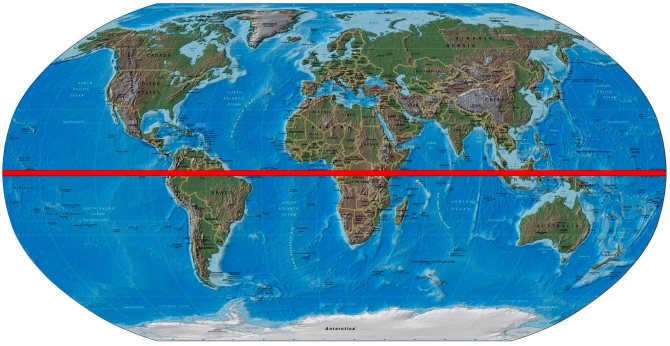
The equator line is depicted on the world map.
It can be said that the shape of our planet resembles that of a sphere, with an average radius of 6371.3 km. However, this representation is not entirely accurate and may not always be suitable for precise calculations. When considering scientific concepts and measurements, it is understood that the Earth is not a perfect sphere. Instead, experts describe its shape using the concepts of geoid or ellipsoid.
Isaac Newton and Christian Huygens discovered the non-ideal shape of our planet in the 17th century. The Earth is not a perfect sphere due to its rotation around its axis and the resulting centrifugal force. This force causes the planet to have a flattened shape, with the equator being wider than the poles. In fact, the polar radius is 21.38 kilometers shorter than the equatorial radius.
Here’s an interesting fact: the Congo River in Central Africa is the fullest and second longest river on the continent. What sets it apart is that it is the only river in the world that crosses the equator twice.
The Earth’s rotation speed is highest at the equator. This can be explained by the fact that the equator has the largest radius on the planet. Speaking of which, the length of the equator is 40,075 kilometers.
Kilometers
and if this value is divided by 24 hours (the duration for which the planet completes one revolution), we can determine the rotational velocity of the Earth at the equator. Therefore, at the equator, it is approximately 1670 km/h. As we move closer to the poles, the speed decreases.

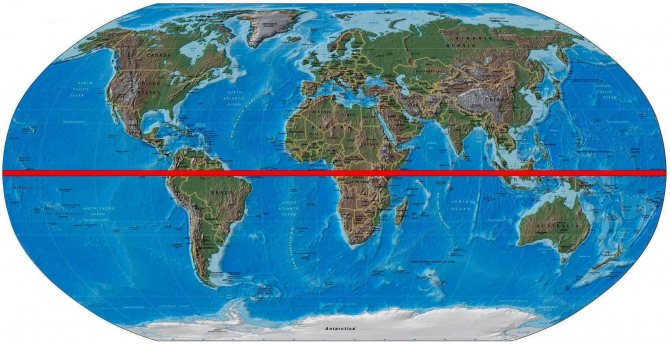

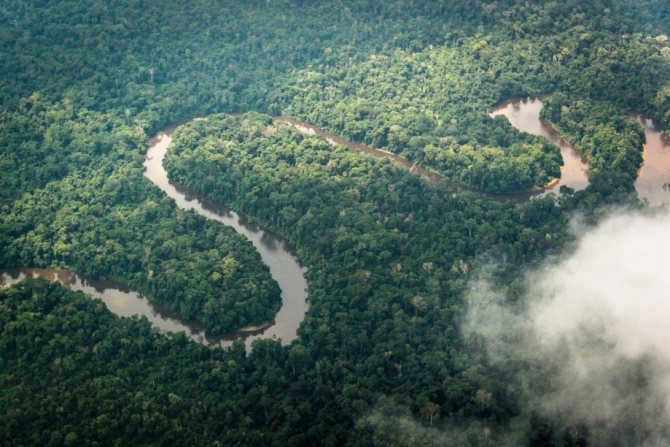
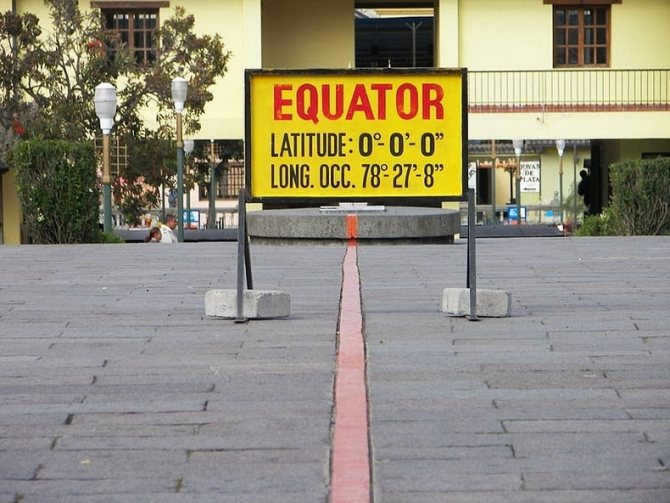
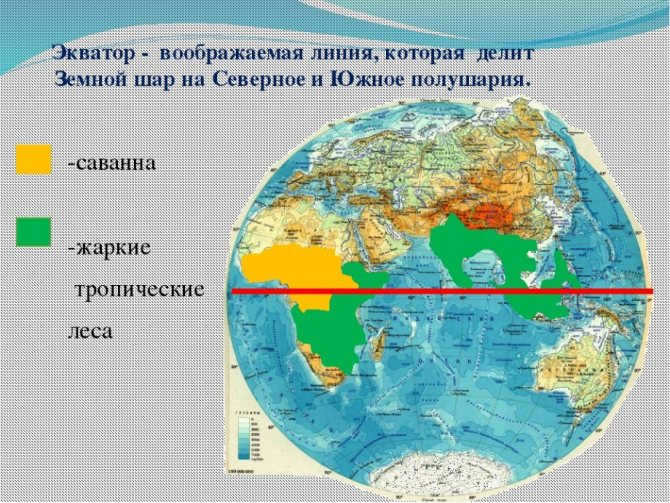
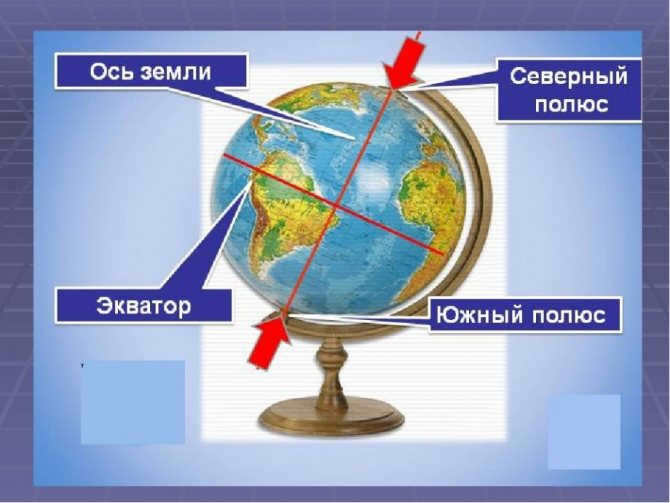
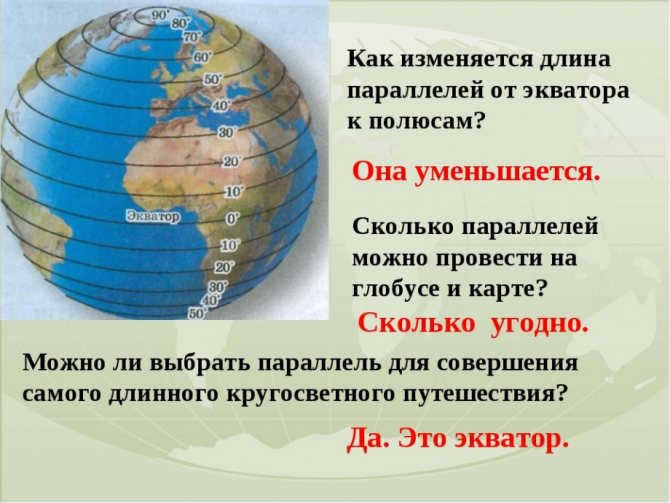
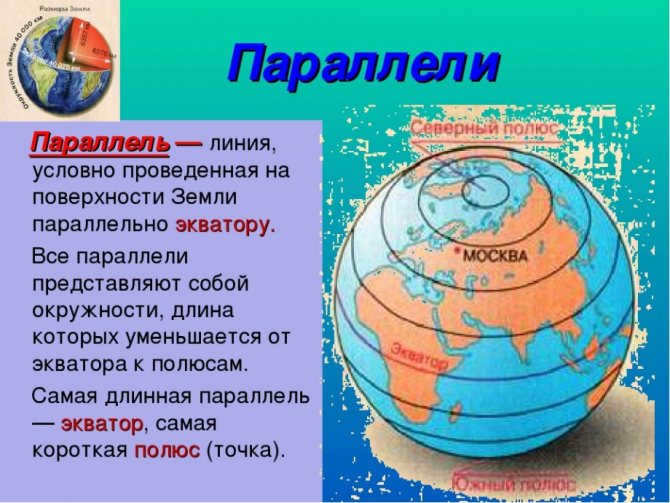
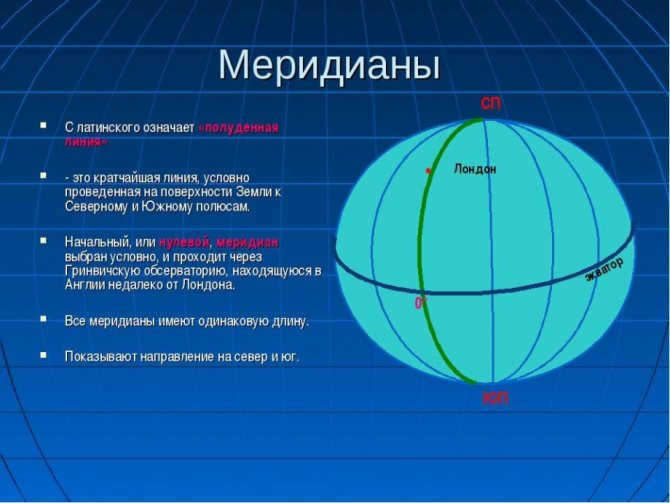

In order to accomplish this task, he needed to measure the duration of time it took for the Sun’s rays to reach the well in his yard and then use that information to calculate the radius of the planet and, consequently, the length of the equator. Based on his calculations, the equatorial line was determined to be 39,690 kilometers, which closely aligns with the modern value with only a slight discrepancy.
Following this, astronomers and mathematicians from various countries around the world attempted to calculate the length of the equator. In the early 17th century, the Dutch scientist Snellius proposed a method for determining the length of a line without considering any obstacles such as elevations or mountain ranges that may be present along it. Then, in 1941, the Soviet geodesist Fyodor Krasovsky successfully calculated the length of the Earth’s ellipse, which has since become the standard for scientific research in this field.
The international organizations IAU and IUGG have accepted the actual equator length of 40,075.696 km as their basis, with a margin of error of 3 meters. This margin of error accounts for the uncertainty in the average radius of the planet.
Equator, Longitude, and Latitude
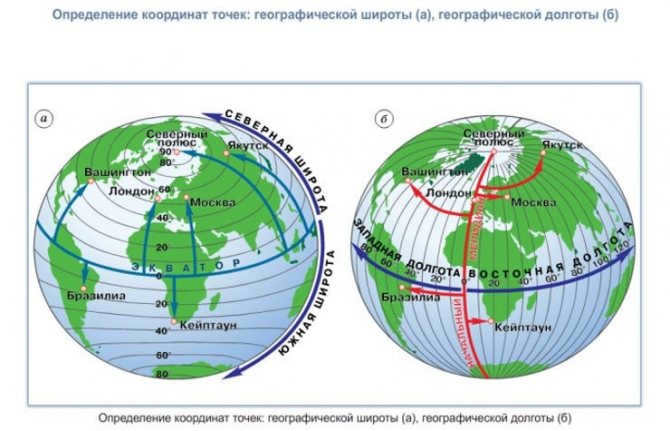
The equator, longitude, and latitude are important geographical concepts. The equator, which is designated as latitude equals 0°, is one of the five latitudes that are widely accepted by the geographic community. The other four latitudes include the Arctic Circle, the South Polar Circle, the Tropic of Cancer, and the Tropic of Capricorn.
Out of all these latitudes, the equator is the only one that can be considered a great circle.
Great circles can also be referred to as parallels because they fit the definition. However, it should be noted that the Earth is shaped like an ellipsoid, so the length of any parallel is smaller than the equator, and therefore the halves are also smaller.
Fascinating fact: There is a city called Macapa in Brazil that is located in two hemispheres simultaneously. In the center of the city is a soccer stadium called Estadio Milton Correa. The center field line of this stadium runs almost directly along the equator. The Marco Zero monument is located not far from the sports facility.
Regions situated along the equator experience the briefest periods of sunrise and sunset. This occurrence can be attributed to the fact that, for the majority of the year, the Sun’s daily trajectory is nearly perpendicular to the horizon. The duration of daylight hours, spanning from sunrise to sunset, remains relatively constant throughout the year. This timeframe is approximately 14 minutes longer than the nighttime hours, owing to atmospheric refraction (the bending of the sun’s rays) and the practice of measuring sunrise from when the top, rather than the center, of the sun’s disk touches the horizon.
Fascinating: How are lakes formed? Detailed explanations, captivating imagery, and engaging videos
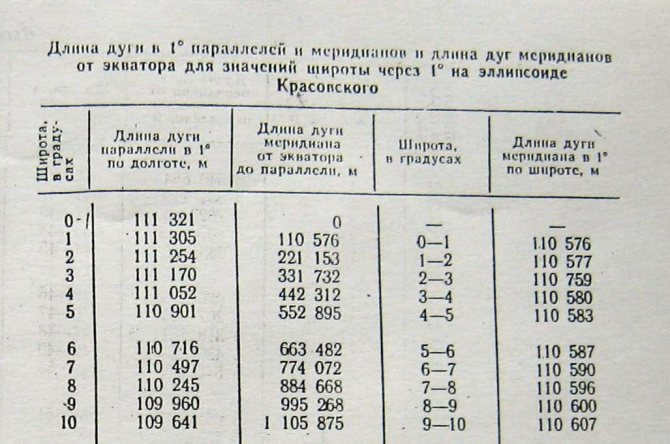
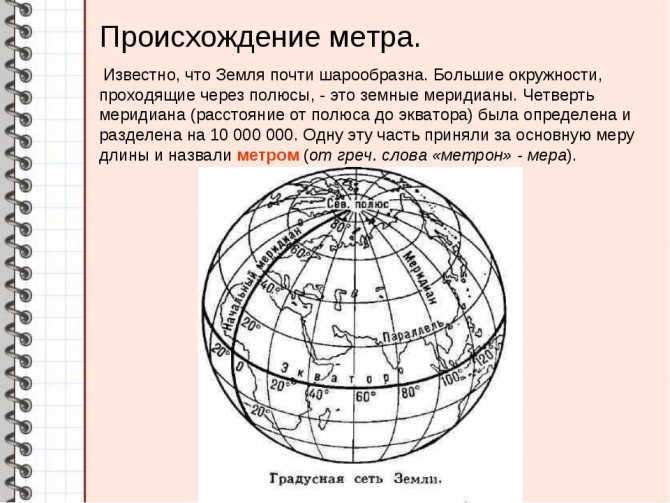
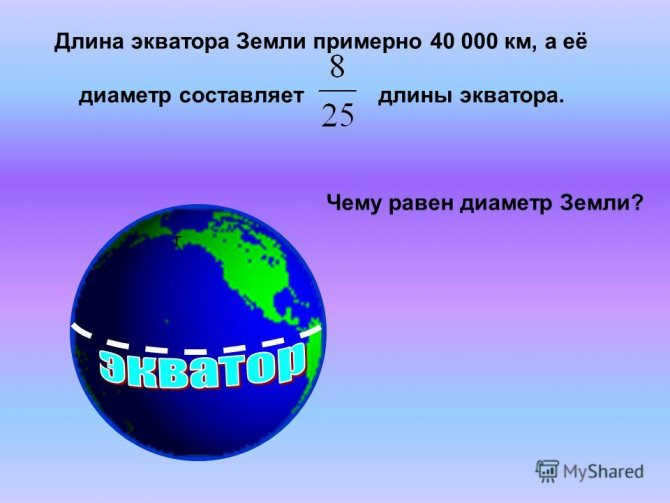
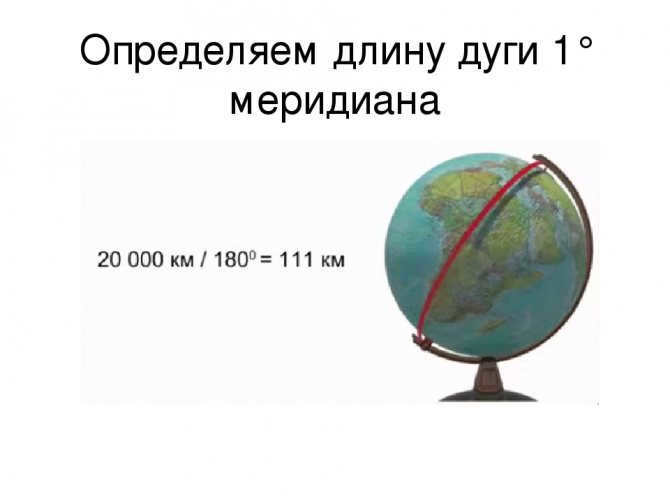
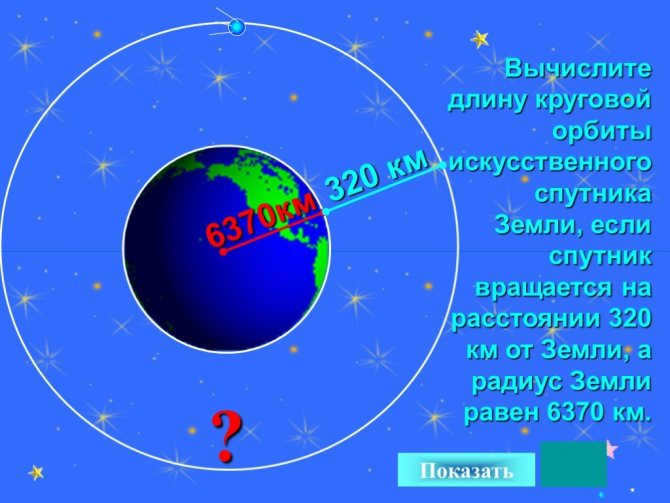
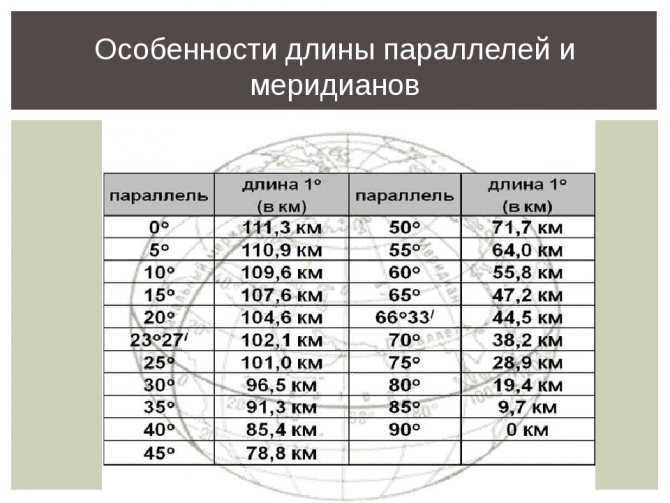
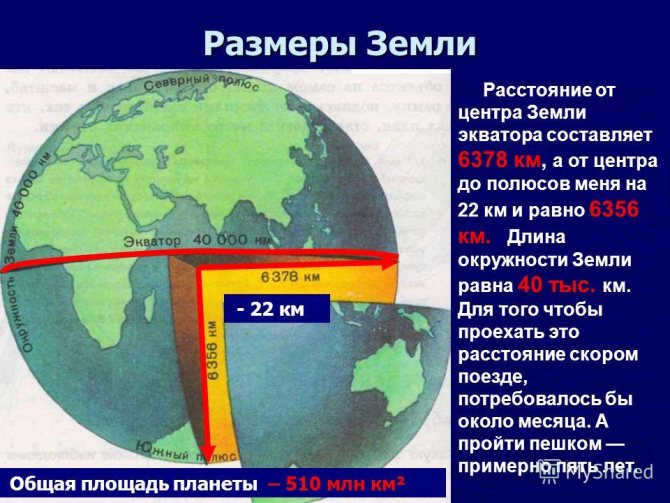
The equator is a line that divides the Earth into two hemispheres, the Northern and Southern. It serves as the starting point for measuring latitude. The equator passes through 14 countries, including Ecuador, Brazil, Indonesia, Kenya, and Congo. In certain areas, the equator runs in a manner that divides towns and geographic features in half.
Notably, the capital city of Ecuador, Quito, the Brazilian city of Macapa, and the Ecuadorian volcano Wolf are situated directly on the equator. Additionally, the equator intersects 33 islands in Indonesia, Lake Victoria in Africa, and the Amazon River.
The equator’s climate
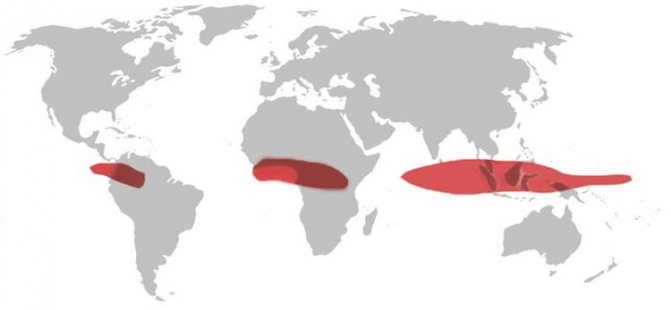
The equatorial climate zone can be seen on the map of the world. This zone is influenced by the tilt of the Earth’s axis in relation to its orbit around the Sun. As the Earth orbits the Sun, different hemispheres tilt towards or away from the Sun, resulting in changes in the amount of solar radiation received. The hemisphere that is tilted towards the Sun receives more solar radiation and experiences summer, while the hemisphere tilted away from the Sun receives less radiation and experiences winter.
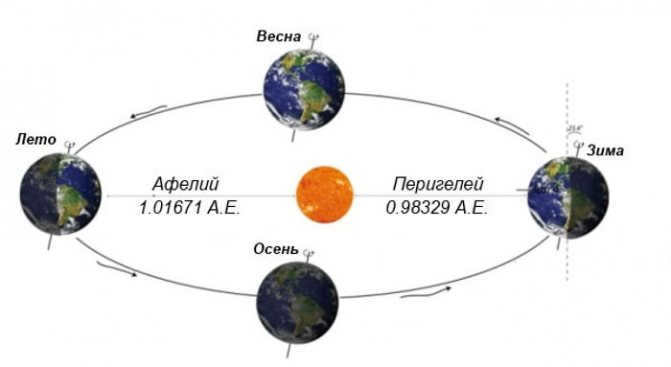
The rotation of the Earth around the Sun
Areas situated at the equator typically experience a tropical rainforest climate, also referred to as an equatorial climate. While certain regions have a tropical monsoon climate due to cold currents, resulting in a dry season in the middle of the year. Additionally, the Somali current, generated by the East Asian monsoon, creates an extremely dry climate on the Somali Peninsula, despite its equatorial position.
Fascinating fact Some countries have derived their names from the term “equator”: Ecuador, Equatorial Guinea, Equatorial Africa.
When one travels away from the equator line in either direction, there is a decrease in the amount of solar radiation, which leads to the creation of different climatic zones. However, due to the consistent weather throughout the year in the equatorial zone, this area is home to an unparalleled variety of plant and animal species. The forests that thrive here are often referred to as the “lungs of the Earth” as they produce the oxygen that sustains all living organisms.
Signs and customs
The equator may be nothing more than a symbolic division between the two hemispheres, but it has always fascinated people. Sailors from different nations have unique customs when they cross the zero latitude, especially if it is their first time. In places where the equator passes through inhabited areas, distinct signs and structures are always built to make the imaginary line tangible. It is a rare occurrence for a traveler to miss the chance to stand with one foot in the Southern Hemisphere and the other in the Northern Hemisphere. Once experienced, the name of the Earth’s longest parallel becomes unforgettable.

However, the near-equatorial regions of the Earth possess distinctive characteristics that make them particularly valuable. In these latitudes, the gravitational pull is slightly weaker compared to other areas, and the rotational momentum of the planet is higher. As a result, it becomes possible to significantly reduce the amount of rocket fuel required for launching spacecraft into orbit. It is not a coincidence that the most efficient space launch facility, the Kourou Cosmodrome, is situated in the equatorial region of French Guiana, along the coast of South America.
Countries located on the equator
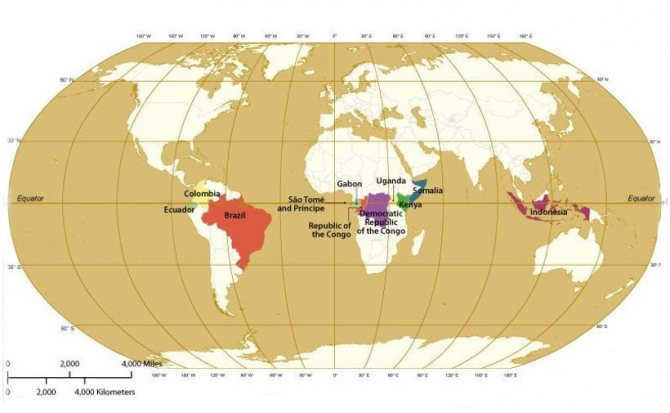
The equator is home to a total of 11 countries. Starting from the Prime Meridian and moving eastward, the countries located at zero latitude are:
- São Tomé and Principe;
- Gabon;
- Republic of Congo;
- Democratic Republic of Congo;
- Uganda;
- Kenya;
- Somalia;
- Indonesia;
- Ecuador;
- Colombia;
- Brazil.
In addition to these countries, there are also two countries whose territorial sea is crossed by the equator, but the equator itself does not touch their land directly:
The equator serves as the optimal starting point for space flights and, consequently, the construction of spaceports. One example is the Guiana Space Center, which is situated in the capital of French Guiana. These types of launch sites have a significant advantage by leveraging the natural rotation of the Earth. This rotation provides an extra boost in speed, reducing the amount of fuel required to propel a vehicle eastward (in the same direction as the planet’s rotation) into orbit. As a result, costly maneuvers to correct inclination during launches can be avoided. If you notice any errors, please highlight the text and press Ctrl+Enter.
Equator
The coordinate system that covers the entire globe – a graphical representation of the Earth – consists of 360 meridians connecting the North and South poles, and 180 lines running parallel to the equator, evenly distributed 90 degrees apart on both sides. Since 1884, the meridian passing through the Greenwich Observatory, situated in the southeastern part of the city of London, has been designated as the prime meridian. The equator, the longest parallel that divides the Earth into the Northern and Southern hemispheres, serves as the starting point for measuring latitude.
Coordinates are measurements of angles, expressed in degrees. Longitude is the angle formed between the plane that passes through the zero meridian – Greenwich – and the line connecting the Earth’s poles, drawn through a specific point. When moving east of Greenwich, up to 180 degrees of longitude, the values are considered positive and it is referred to as the eastern hemisphere. When moving west, the values are negative, and it is called the western hemisphere.
Points that are equidistant from the Earth’s poles make up the equatorial plane. The angle formed between a radius drawn from the center of the Earth to a specific point on its surface and the equatorial plane is known as latitude. The longest parallel of latitude has a latitude value of zero. In the northern hemisphere, this angle is considered positive, ranging from 0 degrees to 90 degrees. In the southern hemisphere, it is considered negative.
The journey to acquiring knowledge is a lengthy and challenging one, but the rewards are truly satisfying. Currently, we possess reliable information regarding the physical characteristics of the Earth’s core:
At the core’s center, the temperature can reach a staggering 6000 degrees Celsius, equivalent to the surface of the Sun! However, unlike the Sun, the core is not powered by nuclear reactions, but rather by gravity. Specifically, it is the compression caused by gravity that fuels the core, with the pressure exceeding atmospheric pressure by a staggering 3.5 million times, measuring at 360 gigapascals. While there are atomic decay processes occurring within the depths of the Earth, their contribution is relatively minimal. Without the immense compression, these processes would be sluggish and far less productive.
The Earth’s core can be divided into classic spherical regions:
- The Earth’s core is larger than both the Moon and Mars, spanning 7,000 kilometers across
- Although it only occupies about 15% of the Earth’s volume, the core is responsible for 30% of the planet’s total mass, weighing in at 1.932 × 10^24 kilograms
- Interestingly, the core’s different layers rotate in opposite directions. The outer liquid core rotates from east to west, while the inner core moves from west to east and spins faster than the Earth. However, the speed difference is minimal, with the inner core outpacing the planet by only a quarter of a degree per year
Moreover, recent studies propose that there exists another layer within the inner core of the Earth known as the “extremely” inner core, which undergoes rotation along a distinct axis. Let’s delve deeper into this phenomenon as well as the other constituents of the Earth’s core.
The inner core
The initial stratum of the core, which directly interfaces with the mantle, is referred to as the outer core. Its upper border lies approximately 2.3 thousand kilometers beneath sea level, while its lower border extends to a depth of 2,900 kilometers. In terms of composition, it does not differ from the underlying layers, as the gravitational pressure is insufficient for the molten metal to solidify. However, its liquid state is a significant advantage of the Earth in comparison to the inner planets within the solar system.
It is the liquid component of the Earth’s core that is responsible for generating the planet’s magnetic field. This magnetic field
. As most readers are aware, the magnetosphere acts as a protective barrier for the Earth, shielding it from charged particles originating from outer space and the solar wind. These particles pose an even greater threat than radiation, as they have the potential to not only harm living organisms, but also disrupt electronic systems. Biologists hypothesize that an active magnetic field played a crucial role in the survival of early single-celled organisms.
Top Articles: Bobtail: a steadfast character with an endearing appearance
What is the mechanism behind the generation of the magnetic field? The magnetic field is created through the rotation of liquid iron and nickel in the core. The magnetic properties of the metals are not relevant to this process – it is entirely a result of dynamic forces. Additionally, the outer core transfers heat to the mantle, leading to intense heating in certain regions. This extreme heat can cause rising magma to reach the surface, resulting in volcanic eruptions.
The central nucleus
Deep within the fluid outer layer lies the central nucleus. This represents the compact core of the Earth, boasting a diameter measuring 1220 kilometers – an equivalent size to that of Charon, the moon of Pluto. Charon’s moon.
as well as its celestial companion.
Pluto.
. This particular segment of the nucleus exhibits immense density – the average matter concentration reaches a remarkable 12.8-13g/cm3, which is double the density of iron, and extreme heat – temperatures soar to a renowned 5-6 thousand degrees Celsius.





